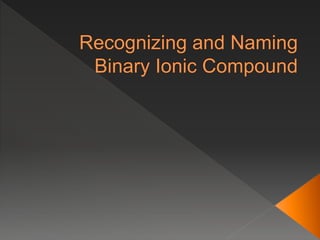
BINARY IONIC COMPOUND.pptx
- 3. Binary Compound A compound in which only 2 elements are present NaCl, CO2, NH3, and P4O10 Binary Ionic Compound An Ionic compound in which one element present is a metal and the other element present is non-metal NaCl Metal Non-Metal
- 4. Which of the following binary compounds would be expected to be an ionic compound? Al2S3 CO2 H2O MgCl2 KF PF3 NH3 Fe2O3 Ionic Not Ionic Ionic Not Ionic Not Ionic Ionic Ionic Not Ionic
- 5. Rule: The full name of the metallic element is given first, followed by a separate word containing the stem of the metallic non- metallic element and the suffix –ide. Metal Non-Metal potassium chloride Note: “chlor” is the stem of the non-metallic element chlorine
- 7. Name the following binary ioniccompounds MgO Al2S3 K3N BeO CaCl2 Li3P Na2S BaI2 magnesium oxide potassium nitride calcium chloride sodium sulfide aluminum sulfide berellium oxide barium iodide lithium phosphide
- 8. What is Variable Ionic Behavior? Pertains to the less predictable behavior of some metals because they have the ability to form more than one type of ion.(Ex. Fe2+ and Fe3+) Note: all inner transition elements, most transition metals, and a few representative metals exhibit variable ionic charge behavior.
- 9. Rule: “The charge of the metal ion must be included in the name.” Ex. FeCl2 and FeCl3 iron (II) chloride iron (III) chloride
- 10. Old Method: “Latin name is used + the suffix –ic and –ous.” “ic” is used for ion of higher charge, and “ous” for ion of lower charge. FeCl2 ferric chloride ferrous chloride FeCl3
- 11. Calculating for the charge of Metal Ion Ionic charge must add to zero Ex. FeCl2 iron charge + 2 (chlorine charge) = 0 Iron charge + 2(-) = 0 Iron charge = 2+
- 13. Name the following compounds, which contain on or more polyatomic ions AuCl Fe2O3 PbO2 Cu2S Gold (I) chloride Lead (IV) oxide Iron (III) oxide Copper (I) sulfide
- 15. ION Monatomic ion “an ion formed from a single atom through loss or gain of electrons.” Ex. Cl-,Na+, Ca2+, N3- Polyatomic Ion “an ion formed from a group of atoms (held together by covalent bonds) through loss or gain of electrons.” Ex. NO3 -, SO4 2-, PO4 3-
- 17. MOLECULE “group of two or more atoms that functions as a unit because the atoms are tightly bound together.” “One of the fundamental units forming a chemical compound” Molecules can occur alone. Polyatomic ions don’t.
- 18. Polyatomic ions are “charged pieces of a compound”, not compounds. They are found associated with ions of opposite charge. Ionic compounds require presence of both positive and negative ions and are neutral overall.
- 20. 1. Most of the polyatomic ions have negative charge, which can vary from -1 to -3. (except NH4 (Ammonium) and H3O+ (hydronium)) 2. 2 of the negatively charged polyatomic ions, OH- (hydroxide) and CN- (cyanide) have names ending in –ide.
- 21. 3. A number of –ate and –ite pairs of ions exist, as in SO4 2- (sulfate) and SO3 2- (sulfite). The –ate ion always has one more oxygen atom than the –ite ion. Both the –ate and –ite ions carry the same charge. 4. A number of pairs of ions exist wherein one member of the pair differs from the other by having a hydrogen atoms present, as in CO3 2- (carbonate) and HCO3 - (hydrogen carbonate or bicarbonate). In such pairs, the charge on the ion that contains the hydrogen is always 1 less than that of the other ion.
- 22. 1. When more than 1 polyatomic ion of a given kind is required in a chemical formula, the polyatomic ion is enclosed in parentheses, and a subscript, placed outside the parentheses, is used to indicate the number of polyatomic ions needed. Fe(OH)3 Iron charge + 3(OH charge) = 0 Iron charge + 3(-1) = 0 Iron charge – 3 = 0 Iron charge = 3+ Iron (III) hydroxide
- 23. 2. So that the identity of polyatomic ions is preserved, the same elemental symbol may be used more than one in chemical formula. NH4NO3 Both NH4 and NO3 has Nitrogen (N) as part of their components. (Ammonium nitrate)
- 24. Determine the chemical formula for the ionic compounds that contain these pair of ions. Na+ and SO4 2- K+ and CO3 2- Mg2+ and NO3- Ca2+ and OH- NH4 + and CN- NH4 + and HPO4 2- Na2SO4 Mg(NO3)2 NH4CN K2CO3 Ca(OH)2 (NH4)2HPO4
- 25. Name the following compounds, which contain one or more polyatomic ions Ca3(PO4)2 Ba(NO3)2 Fe2(SO4)3 Cu3PO4 (NH4)2CO3 (NH4)2SO4 Calcium phosphate Iron (III) sulfate Ammonium carbonate Barium nitrate Copper (I) phosphate Ammonium sulfate
- 30. General, Organic, and Biological Chemistry by H. Stephen Stoker